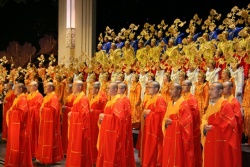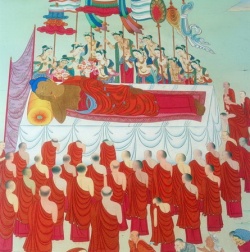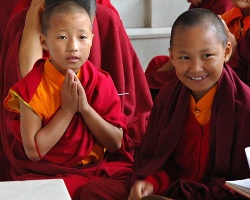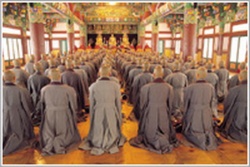Buddhist Education – Bedrock for the Growth of Buddha Dhamma
By Lim Kooi Fong
On February 16, 2002, the Buddhist News Network (BNN, now Buddhist Channel, www.buddhistchannel.tv) interviewed the late Chief Venerable Dr. K. Sri DhammanandaMahaNayakaThera. This candid interview revealed rare and important details of the growth of local Buddhist education during the lifespan of Chief as a monk in Malaysia.
It can be said that the institution of Malaysian Buddhist education, spiritual bedrock to a generation of inspired youths which bloomed in the late 60s right till today, was very much the result of sheer dedication of thishonoured venerable.
The BNN interviewmanaged to bring out many inspired stories and revealed creative ways adopted by the late Chief to overcome challenges to spread the wise and compassionate teachings of the Buddha. The following are excerpts of the discussion.
Chief, can you enlighten us on the state of Buddhist education when you first arrived in (then British ruled) Malaya?
Fifty years ago there was basically no foundation for which could be called as the basis for Buddhist education. When we say “Buddhist education” we must emphatically mean those teachings by the Buddha which points us to self realisation of the characteristics of life, namely dukkha (suffering), anicca (impermanence) and anatta (non-self), and initiate self discipline to cultivate and walk the Noble Eight Fold Path.
There were however, already established Buddhist temples at that time. But most of these places dedicated a bulk of their efforts to chanting, blessing ceremonies and funeral services. In fact, there were a few places where there was no young people participating in religious activities. We could only find mostly elderly people visiting temples and even then, they knew only how to burn joss-sticks and wish for “good luck.”
Also many of the so-called Buddhist temples were actually a mixture of Buddhist-Taoist tradition, and conducted their activities mainly in Chinese. Superstitious rites and rituals were rife, and English educated Malaysians found “Buddhism” then not “modern” enough to attract them.
In fact, even here at the Brickfields Temple (now called Buddhist MahaVihara), much of the activities centred on providing religious services for the Sinhalese community, who were mainly Buddhists. The vihara arranged Sinhalese classes for the children as well as full and new moon pujas. Even then, only the elders from the community attended these functions. The youths in those days seemed to have the idea that religious activities are meant only for the “old people”.
What did you really do to establish Buddhism in the “educational” sense?
To instill a sense for the need of education, the first thing we did was to establish, and to encourage others as well, to form social institutions. This came in manners like group societies, schools and tutorial centres. Without these institutions, we found that we could not really conduct Dhamma teachings or hold public discussions. You have to remember that institutions we take for granted today, like the Sunday Dhamma schools and college based Buddhist societies did not exist then. Books on basic Buddhism were also not freely available. So you see how difficult it was to inform, to teach the public what true Buddhism was all about.
When I arrived in Malaya in 1952, one of the first activities we initiated from this (Buddhist Maha) vihara was to provide public talks. During that time (Malaya under the emergency era), the British government invited me to visit the new villages and requested me to give talks to the communities there. The effect of the talks were good, so much so that it helped dispel so many misconception people had about Buddhism. After that, the temple monks decided that Malaya then needed such services (public talks) and soon this became a regular feature in our Sunday activities. The Sunday talk was later incorporated with Puja and Dhamma related rituals. This was done to attract those who had affinity with the Triple Gem, although they may not understand a word of English.
Slowly, as public acceptance became more and more widespread, our Sunday services, which were conducted in English, attracted other communities apart from the Sinhalese such as the Chinese. This was the moment when you can say that Buddhism transcended race and nationalities. Remember, Malaya was just about to obtain her independence then. So religious and temple affiliations based on certain races were still very strong. You can say that the (Buddhist Maha) vihara was a pioneer somewhat in opening Buddhism up to all Malaysians – regardless of race or creed.
Later, in the mid sixties, due to the public talks I’ve given over the years, we found that more and more young people became interested in Buddhist related activities. This was a time when you can say some form of renaissance was taking place. While in the past where the elders mainly did most of the work in organising activities, now it seems that youths was beginning to take interest in organising events which suited their needs and age groups.
This leads us to another element in the building blocks of Buddhist educational institutions, that is the people themselves. While in the past Buddhism was seen as a “religion for the old”, the sixties and seventies witnessed the mass participation of Malaysian youths. The mobilisation of the youth movements in that period can be considered as the regeneration of Buddhist energy in this country. When you have many young people doing things, then you get a lot of creative results.
And so today, you can see how much Buddhism have developed. You can attend talks almost daily, go to meditation retreats, participate in sutta studies, attend Buddhist seminars and forums.
All over the country, we have almost 300 Buddhist organisations and societies actively organising activities for their respective members and serving their communities. An interesting observation is that almost all of these organisations are run by the youths, especially those at the universities, colleges and schools. This indeed is the fruit of the spiritual awakening of the youth and the big part they play in making Buddhism alive in Malaysia.
You have elaborated on the “vertical” development of Buddhist education in Malaysia. What can you say of the “horizontal” aspect, given the country’s mosaic of a multiracial and multi-religious make up?
All religions teach about love. But ironically, each of them finds it so hard to love one another. To reach out to other religionists, we must be prepared to listen, and to share. The Buddha did not spread His teaching through forced conversions, but through individual realisation. We need to reach out in the same manner, and explain to others why we behave the way we are and what we believe in.
Buddhist education does not stop with only the teaching of our own kind, but to also encourage others to understand us better. This is to reduce fear of the other parties, and through this manner we can learn to live in harmony. The Buddhist Mahavihara has been at the forefront to participate in inter-faiths dialogues – together with our Muslims, Christians, Hindus or Sikhs brothers and sisters.
What can you say of the “Buddhist higher education”, specifically with reference to the Abhidhamma?
There are many ways to learn about Buddhism. One way is to listen to talks. Another way is to read books. And you can also learn through self-cultivation, like meditation. In some ways you can say Buddhism is different from other religions because it emphasises so much about the mind and its processes. Read the suttas, and you’ll find so much of the teachings are dedicated to the understanding and controlling of the mind. It is like a manual of deep psychology.
While many people do not appreciate learning the Abhidhamma, in fact by learning about it, one will develop a deeper understanding of this religion. So much so, one’s saddha (confidence) will never be shaken because they will have intimate knowledge of how their own personal self behave, and will appreciate how a mindful and compassionate lifestyle matters in their relations with other people as well as with other beings.
Please share your thoughts on propagating the Dhamma beyond using traditional methods.
When Victor (Wee) and the Wayfarers came to see me about their wish to commence a hymn singing group, I gave them my blessings. But when they first began singing their first hymn, the orthodox elders and some members of the Sangha made a lot of noise, saying that the group was turning the vihara into a church. But I stood my ground. I said (to the Wayfarers), let them say what they want. If you think you are right, just go ahead. A few years later, those simple Dhamma based hymns inspired a whole new generation of young, committed Buddhists. It also became impetus in re-igniting and rejuvenating the Buddhist youth movements all over Malaysia.
We need to change and adjust to conditions as we progress. During the Buddha’s time, education was low and rural farming was a way of life. Given the environment as such, using stories to convey a certain discourse was the most effective method.
And since Dhamma is timeless, why must we stick to certain ways to spread its message? Propagation methods must suit the time that it is used. If the method is outdated, then the message will not be delivered effectively.
Today, you see many such creative propagation efforts like Buddhist hymns and computer technology to disseminate Buddhism.
People say that you are a hard act to follow. They could well never be a Thera who would be accepted by all the major Buddhist traditions (Theravada, Mahayana and Vajrayana) both in Malaysia and Singapore in the near future. What advise would you give to the coming generations with regards to the further development of Buddhist education here and in the world?
Well, you cannot say that whatever I’ve done will be something which is difficult for others to follow. All this comes down to just one thing – communication. I cannot speak Chinese, norTibetan and my Malay is just passing. Some how if we sincerely speak the language of the Dhamma, most people will understand that.
Remember, not too long ago the knowledge of the Dhamma in this country was so bad that very, very few people know about the life of the Buddha. Today, even five year old children, from all streams and languages, know about it. Once upon a time, going to temple means to only worship and offer prayers. Today, we go there to learn about the basic teachings.
We must ever keep in mind that learning the Dhamma is not about gaining book knowledge. It is not something we put into memory and then use it for public debate. The true and real purpose of learning is to gain personal development, of enriching the mind, and cultivating the spiritual side of our being. Above all else, Buddhist education is more about moral and spiritual development. If the coming generation can appreciate this, then Buddhism will have a bright future in this country.
Biodata of Lim Kooi Fong
KooiFong has been a student of Buddhism and Dharma teacher for more than 25 years. He is the founder of the Buddhist Channel (www.buddhistchannel.tv) and Buddhist Travel (www.buddhistravel.com). He is a life member of UpakaraKalyana Mitta Buddhist Assocation (UKMBA) and Vice-President of PersatuanPerkembanganAjaranDhamma” (Dhamma Development Society). He currently manages a web development company in Petaling Jaya. He actively conducts Dharma talks for Buddhist societies around the Klang Valley.








